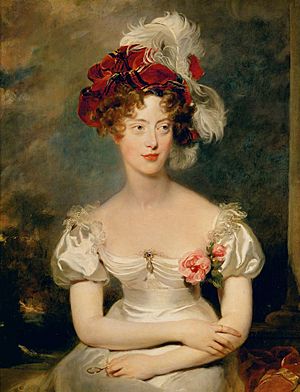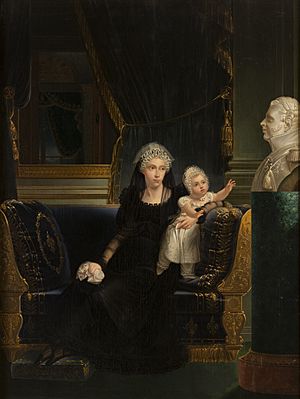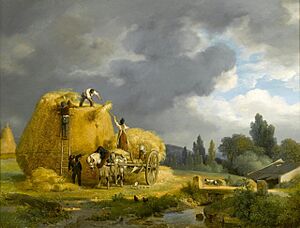Marie-Caroline of Bourbon-Two Sicilies, Duchess of Berry facts for kids
Quick facts for kids Princess Marie-Caroline |
|||||
|---|---|---|---|---|---|
| Duchess of Berry Duchess della Grazia |
|||||

Portrait by Sir Thomas Lawrence, 1825
|
|||||
| Born | 5 November 1798 Caserta Palace, Caserta, Kingdom of Naples |
||||
| Died | 16 April 1870 (aged 71) Brunnsee, Styria, Austria-Hungary |
||||
| Burial | Mureck Cemetery, Mureck, Austria | ||||
| Spouse |
Prince Charles Ferdinand, Duke of Berry
(m. 1816; died 1820)Ettore Lucchesi-Palli, 8th Duke della Grazia
(m. 1831; died 1864) |
||||
| Issue | From first marriage: Princess Louise Élisabeth of France Prince Louis of France Louise Marie, Duchess of Parma and Piacenza Henry V of France From second marriage: Anna Maria Lucchesi-Palli Clementina, Countess Zileri dal Verme Francesca, Princess of Arsoli Maria Isabella, Countess of Conti Adinolfo Lucchesi-Palli, 9th Duke della Grazia |
||||
|
|||||
| House | Bourbon-Two Sicilies | ||||
| Father | Francis I of the Two Sicilies | ||||
| Mother | Archduchess Maria Clementina of Austria | ||||
| Religion | Roman Catholicism | ||||
| Signature | |||||
Marie-Caroline of Bourbon-Two Sicilies, Duchess of Berry (born Maria Carolina Ferdinanda Luise; November 5, 1798 – April 16, 1870) was an Italian princess. She became part of the French royal family when she married, and she was the mother of Henri, Count of Chambord.
Life of a Princess
Early Years and Family
Caroline was born at Caserta Palace in Naples, Italy. She was the oldest child of Prince Francesco, who would later become King Francis I of the Two Sicilies. Her mother was Archduchess Maria Clementina of Austria. Caroline's parents were first cousins, meaning their parents were siblings.
She was named after her grandparents, Maria Carolina of Austria and King Ferdinand of Naples. She also shared a name with her maternal grandmother, Maria Luisa, Holy Roman Empress.
Caroline spent her childhood in Palermo and Naples. Her mother passed away in 1801. Her father remarried in 1802 to Infanta Maria Isabella of Spain, who was also a first cousin. They had twelve more children together.
Marriage and French Royal Life
In 1816, when Caroline was 17, she married Charles Ferdinand, Duke of Berry. He was the nephew of Louis XVIII of France, the King of France. Their wedding took place on April 24, 1816, in Naples. After her marriage, Caroline became known as the Duchess of Berry, or Madame de Berry in France.
Even though their marriage was arranged, Caroline and Charles Ferdinand were very happy together. They lived at the Élysée Palace in Paris, which was given to them.
They had four children. Sadly, only their two youngest children survived past infancy. Their daughter, Louise Marie Thérèse of Artois, was born in 1819.
A "Miracle Child" and Political Role
In 1820, a great tragedy struck when the Duke of Berry was killed. Caroline was pregnant with their fourth child at the time. This child, Henri, Count of Chambord, was born later that year. His birth was seen as a "miracle" because it meant the direct family line of King Louis XIV of France would continue. Henri was expected to become the next king.
As Henri's mother, Caroline became a very important person in French politics during a period called the Bourbon Restoration. This was when the Bourbon royal family had returned to power after the French Revolution and Napoleon.
In 1824, King Louis XVIII died. Caroline's father-in-law became the new king, Charles X of France.
Exile and Attempts to Regain the Throne
In 1830, a new revolution, called the July Revolution, happened in France. King Charles X was overthrown. Both Charles and his older son gave up their right to the throne. However, their cousin, Louis Philippe of Orléans, became king instead of Henri.
Caroline and Henri went into exile with Charles and his family. They lived in Bath, England, for a while, and then in Edinburgh, Scotland. Caroline did not like living in Edinburgh. She also strongly disagreed with her son being kept from the throne. She believed Henri was the rightful king and declared herself his regent, meaning she would rule for him until he was old enough.
In 1831, she left Edinburgh and returned to her family in Naples. From Naples, she secretly planned a rebellion to put Henri back on the throne. This group of supporters was called the Legitimists. She also secretly married an Italian nobleman, Ettore Carlo Lucchesi-Palli, in December 1831.
In April 1832, she landed in France near Marseille. She didn't get much support there, so she went to the Vendée and Brittany regions. She managed to start a short rebellion in June 1832, but her followers were defeated. After hiding for five months in a house in Nantes, she was betrayed and arrested in November 1832. She was then imprisoned in the Chateau of Blaye.
Later Life and Family
While in prison, Caroline gave birth to a daughter. When her secret marriage was revealed, she lost the support of many Legitimists. She was no longer seen as a threat by the French government, and she was released in June 1833.
She moved to Sicily with her husband. The daughter born in prison died young, as did another daughter born the next year. However, they had four more children who survived. In 1844, Caroline and her husband bought a beautiful palace called Ca' Vendramin Calergi in Venice, Italy.
Later, during a time of political unrest in Italy called the Risorgimento, they had to sell their palace. They then moved to Brunnsee, near Graz in Austria. Her husband died there in 1864, and Caroline passed away in 1870.
The famous French writer Alexandre Dumas wrote two stories about her and her attempts to regain the throne.
Patron of the Arts
Supporting Theatre and Art
The Duchess of Berry loved going to the theatre. She was a special supporter of the Théâtre du Gymnase, which even changed its name for a time to the théâtre de Madame in her honor. She often attended performances at the Odéon. She also helped raise money for charity performances, like one for victims of a fire at a circus.
Caroline and her first husband, Charles-Ferdinand, were also passionate art collectors. In 1822, she held an art sale. What was special about this sale was its catalogue, which included pictures of all the artworks made using a new printing method called lithography. This method had only recently been fully described in 1818. The lithographs in her catalogue helped make this new technique popular for reproducing art.
She collected many landscape paintings, including some by Ruisdael. She also owned paintings showing everyday life scenes by artists like Auguste-Xavier Leprince. She supported the Sèvres Porcelain Manufactory, ordering beautiful porcelain works from them.
Children
Caroline had children from both of her marriages.
Children with Charles Ferdinand, Duke of Berry:
- Princess Louise Élisabeth (born and died 1817)
- Prince Louis (born and died 1818)
- Princess Louise Marie Thérèse, Duchess of Parma (1819–1864)
- Prince Henri, Duke of Bordeaux and Count of Chambord (1820–1883)
Children with Ettore Carlo Lucchesi-Palli, 8th Duke della Grazia:
- Anna Maria Rosalia Lucchesi-Palli (born and died 1833)
- Clementina Lucchesi-Palli, Countess Zileri dal Verme (1835–1925)
- Francesca di Paola Lucchesi-Palli, Princess di Arsoli (1836–1923)
- Maria Isabella Lucchesi-Palli, Marchesa Cavriani then Contessa di Conti (1838–1873)
- Adinolfo Lucchesi-Palli, 9th Duke della Grazia (1840–1911)
Images for kids
-
Marie-Caroline of the Two Sicilies, Duchess of Berry, by Jean-Baptiste Paulin Guérin, late 1820s.
See also
 In Spanish: María Carolina de Borbón-Dos Sicilias (1798-1870) para niños
In Spanish: María Carolina de Borbón-Dos Sicilias (1798-1870) para niños




